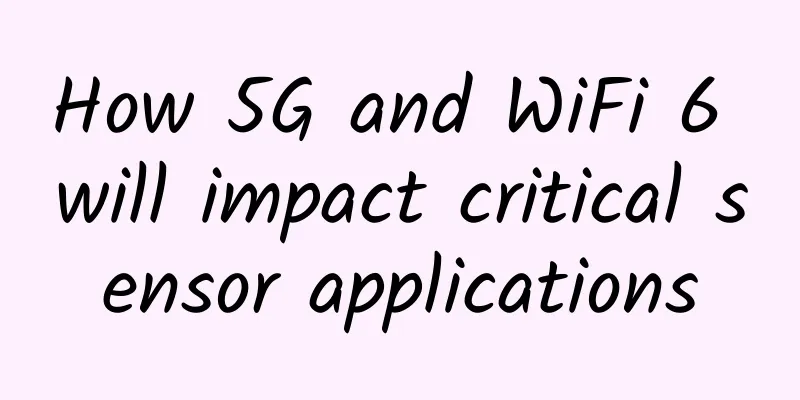How 5G and WiFi 6 will impact critical sensor applications

|
We live in an age where wireless communications and remote computing are advancing at an incredible pace. For some applications, such as consumer products like thermometers or smart refrigerators, the development of a cybersecurity strategy may only require focusing on how well a particular manufacturer implements the device's connectivity protocols. For other applications, such as smart city technologies like transportation systems or devices monitoring the power grid, cybersecurity becomes a more complex and serious topic. We routinely advise clients on the topic of network device security when it comes to gunshot detection sensors, as we know these sensors and the data they carry are critical to the safety of law enforcement, first responders, and their users. In this regard, the rise of 5G and WiFi 6 will certainly have an impact on gunshot detection technology. Mature communication technologies begin to overlapSimply put, 5G will be the latest technology standard for extremely wide-area, highly mobile communications applications; while WiFi 6, as most of us will intuitively understand, is for multi-device connectivity in smaller areas in businesses and homes. While each side touts the higher data throughput, lower latency, and improved security of each technology, what may be less obvious is that the two technologies have begun to move into each other's territory. The increase in Internet of Things (IoT) devices, such as weather stations on city buildings, has forced the WiFi development community to look for better ways to connect more devices in larger public areas. On the 5G side, factories that choose to create internal 5G networks will benefit from assembly line robots and material supply resources that can share large amounts of data with almost zero latency. For the beleaguered physical security professional about to be bombarded with the latest vendor marketing hype, two questions jump to mind: What should I be aware of when considering equipment using these technologies? And when should I start considering upgrading my sensors and network platforms? Good news: Data security is getting betterBoth 5G and WiFi 6 are developed by IT standards organizations that understand the importance of security for connected devices and data. For example, 5G was developed specifically with the following features in mind: resiliency, communications security, identity management, privacy, and security assurance. On the WiFi 6 front, the Wi-Fi Alliance will now require WPA3-level security certification for all Wi-Fi 6E devices — eliminating backward compatibility with older WiFi-enabled devices, which often leads to security vulnerabilities. WiFi 6 will also now enforce encryption of all user data. One important thing to remember is that these technologies may not soon be offered by vendors as an “either-or” solution—your phone can connect to both, for example. In fact, these technologies are complementary, as a large company or city could use devices that use either 5G or WiFi 6 or both. For more details on the security features and benefits of 5G and WiFi 6, see Cisco’s recent white paper at https://bit.ly/CiscoWhitepaper. The bad news: increased riskAs the old saying goes, only a bad craftsman blames his tools. While both 5G and WiFi 6 offer powerful performance and security features, poor implementation or configuration can create security vulnerabilities. Here are some of the issues that these two technologies need to address: Do customers really need 5G or WiFi 6?The previous WiFi standard (WiFi 5) specified a theoretical speed of 3.5 Gbps; WiFi 6 proposes a maximum theoretical speed of 9.6 Gbps. They both exceed standard cable speeds, which hover around 1 Gbps. If these were the only statistics considered, one would think that every IoT manufacturer should be rushing to adopt these new technology tools; however, as we all know, there is lab performance and then there is real-world performance. In a recent study, analysts determined that if you are less than 6 feet from your WiFi router, the optimal data transfer speed for a WiFi 5 signal is about 867 Mbps (more information available at: www.increasebroadbandspeed.co.uk/realistic-speeds-wi-fi-5andwi-fi-6). This is well below standard cable speeds and is still susceptible to signal interference and interception. Should you be paying close attention to WiFi 6 and 5G? The answer depends on an organization’s goals. WiFi 6 and 5G demonstrate that more devices can now connect at higher speeds – but is this really needed for security purposes? If a customer is connecting hundreds of users who all have high data throughput needs – such as a school full of students using virtual reality headsets, or an entire stadium of fans accessing augmented reality smartphone apps – the answer is yes. However, if the end user only needs to send 1 Mb of data per second – the equivalent of 1 minute of compressed MP3 audio or a 10-megapixel picture from a digital camera – then the answer is a resounding no. Applying it to gunshot detection sensorsManufacturers of critical sensors, such as gunshot detection sensors, must ensure that these devices are always available and that the data they transmit cannot be tampered with. Availability in this context means that sensors, whether wireless or connected via Power over Ethernet (PoE) cables, must always be able to send data to a centralized software application. New WiFi standards are interesting and provide new analytical work for engineering teams. For a typical gunshot detection client, we would first recommend as many wired PoE sensors as are relevant to the structure being monitored. Wired has traditionally always provided better stability, bandwidth, and latency than wireless, as well as providing a reliable power source (no batteries required). It is extremely difficult to interrupt or attempt to manipulate the signal from the sensor. If it is not possible to run a cable to the sensor, a wireless-enabled sensor must be used; however, we do not use traditional WiFi frequencies for wireless gunfire detection sensors. This is in part due to the often complex and confusing compatibility challenges between wireless access points (APs) and endpoints, as there are often incompatibilities between the two. Another reason to avoid conflicts with the corporate wireless network is to ensure that traffic between the gunfire sensor and the backend application does not compete with other services. This will help prioritize sending sensor health and gunfire detection messages—important considering that sending critical messages is the key to having a gunfire detection system in the first place. Finally, use of “standard” WiFi frequencies may not be optimal due to building structures and other physical interferences common in most corporate or educational facilities. Data transmission stability and securityAs vendors begin to roll out IoT sensors and devices that leverage 5G and WiFi 6, security professionals will need to work with end-user IT departments to understand how their current infrastructure will interact with these new systems. Sometimes the best solution is one that is designed to run completely off of an existing IT network platform. For example, the Guardian Indoor Wireless Gunshot Detection Sensor leverages LoRa (Long Range) wireless communication, which is common in the IoT space due to its lower power consumption, longer range, ability to operate at different (sub-Ghz) frequencies, and - most importantly - does not interfere with other WiFi installations. Given that the sensors don’t transmit large amounts of data (no voice or acoustic data, only an average of about 0.5 KB of text data per second), there’s no need to burden end users with expensive, complex components that could add unknown variables to their IT security environment. Finally, when evaluating data transmission, WiFi technologies that operate at higher frequencies, such as the new WiFi 6 standard, reportedly cannot penetrate physical barriers such as concrete walls as effectively as older technologies that operate at lower frequencies. Most physical security professionals have enough work to do without having to become IT security experts. While it is the vendor’s job to explain why a new technological advancement will help someone perform more effectively, their first responsibility should always be to provide a proven and effective solution. Upgrading to new technologies is best accomplished through smaller, pilot-based programs that allow integrators and end users to evaluate all aspects of the new platform—especially how issues such as backward compatibility are addressed. |
<<: Computers won’t lie. If something is abnormal, there must be something fishy going on!
>>: Akamai Releases 2021 Annual Sustainability Report
Recommend
DiyVM: 50 yuan/month-2GB/50GB/5M/Hong Kong CN2 line
DiyVM is a brand of Hong Kong Ruiou International...
Juniper Networks will aggressively enter the OTT market in 2018, connecting the world with secure and efficient networks
[51CTO.com original article] From June 7 to 8, 20...
Will Wi-Fi 7 be a revolution?
A Google search for “famous members of Generation...
VMISS 20% off for all items, Korea/Japan/Hong Kong CN2/Los Angeles CN2 GIA/9929/CMIN2 etc. starting from 21 yuan/month
VMISS updated its promotional plan in December an...
Liu Liehong from the Ministry of Industry and Information Technology: 5G has become an important driving force for high-quality economic development
The 2021 Mobile World Congress (MWC) Shanghai Exh...
In addition to base stations, what else should major cities pay attention to in 5G construction?
It has been a year since 5G was officially put in...
HostMayo: $2.5/month-1GB/20G SSD/unlimited traffic/Los Angeles data center
I searched the blog and found that the earliest i...
SoftShellWeb: $3.5/month KVM-1GB/15GB/2TB/San Jose & Netherlands Data Center
SoftShellWeb recently launched several VPS monthl...
Technical Tips | Alibaba Cloud's Practical Exploration of Building Lakehouse Based on Hudi
1. Data Lake and Lakehouse At the 2021 Developer ...
Yecao Cloud: Hong Kong dedicated server from 299 yuan/month, Hong Kong VPS annual payment from 138 yuan
Yecao Cloud is a Chinese hosting company founded ...
The latest market analysis shows that Bluetooth is becoming an important driving force in the IoT industry
As early as several years ago, major market resea...
Tianyi Cloud's transformation and upgrading provides cloud services that are most in line with customer needs
On June 30, 2016, China Telecom and Huawei offici...
Build an HTTP experimental environment by yourself
[[326829]] This is the last lecture of the "...
The secrets of Netty network programming, just read this one
Netty version: 4.1.55.Final Traditional IO model ...
The overall price of 5G mobile phones fell in January 2021
2020 is a year of rapid development of 5G. The sa...









